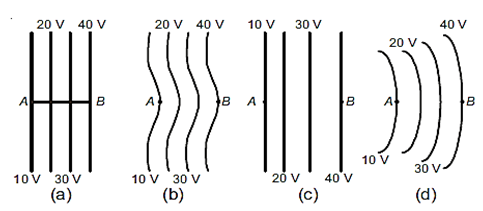 Multiple Choice Questions
Multiple Choice QuestionsWater falls from a height of 60 m at the rate of 15 kg /s to operate a turbine. The losses due to frictional
8.1 kW
10.2 kW
12.3 kW
12.3 kW
A tube of length L is filled completely with an incompressible liquid of mass M and closed at both the ends. The tube is then rotated in a horizontal plane about one of its ends with a uniform angular velocity ω. The force exerted by the liquid at the other end is




The diagrams below show regions of equipotentials
A positive charge is moved from A to B in each diagram.
Maximum work is required to move q in figure (c).
In all the four cases the work done is the same.
Minimum work is required to move q in figure (a).
Minimum work is required to move q in figure (a).
Consider a drop of rain water having mass 1 g falling from a height of 1 km. It hits the ground with a speed of 50 m/s. Take g constant with a value 10 m/s2. The work done by the (i) gravitational force and the (ii) resistive force of air is
(i) – 10 J (ii) –8.25 J
(i) 1.25 J (ii) –8.25 J
(i) 100 J (ii) 8.75 J
(i) 100 J (ii) 8.75 J
The work done in pulling up a block of wood weighing 2 kN for a length of 10 m on a smooth plane inclined at an angle of 15° with the horizontal is
9.82 kJ
89 kJ
4.35 kJ
5.17 kJ
If the heat of 110 J is added to a gaseous system, whose internal energy is 40 J, then the amount of external work done is
180J
70J
110J
30J
Amount of work which can be obtained from 200 cal heat, will be
280 J
800 J
420 J
840 J
D.
840 J
Amount of work done is given by
W=200cal= 200×4.2 J= 840 J (1 cal=4.2J)
The spring extends by x on loading, then energy stored by the spring is (if T is the tension in spring and k is
spring constant
